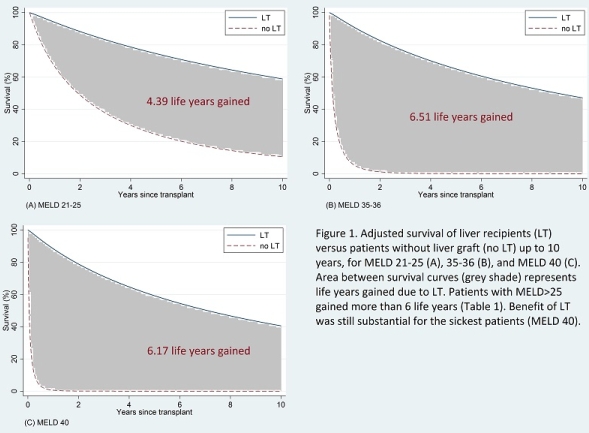MELD as a Metric for Survival Benefit of Liver Transplantation.
JHU, Baltimore.
Meeting: 2016 American Transplant Congress
Abstract number: B260
Keywords: Allocation, Liver transplantation, Survival
Session Information
Session Name: Poster Session B: Liver: MELD, Allocation and Donor Issues (DCD/ECD)
Session Type: Poster Session
Date: Sunday, June 12, 2016
Session Time: 6:00pm-7:00pm
 Presentation Time: 6:00pm-7:00pm
Presentation Time: 6:00pm-7:00pm
Location: Halls C&D
MELD predicts waitlist mortality and thus, patients with higher MELD get higher priority in liver allocation. However, this disease severity based allocation system is controversial due to the concern that the sickest patients might not benefit from liver transplantation (LT). We conducted a national study to quantify survival benefit of LT across MELD strata.
Methods: We identified adult liver-only registrants/recipients between 2006-2015 from SRTR. Patients with status1 or exception points were excluded. We compared deceased donor recipients to patients waiting for LT, using generalized gamma parametric survival analysis and adjusting for MELD, age, gender, race, blood type, liver diseases, malignancy, and insurance. Predicted change in survival and life years gained due to LT (truncating at 10 years) was estimated at different levels of MELD.
Results: Out of 62,770 patients, 24,712 (39.4%) received LT. Median (IQR) MELD at transplant was 25 (19-33). LT reduced life expectancy by 49% (time ratio (TR)=0.390.510.67, p<0.001) for patients with MELD 6-10, but substantially extended life expectancy for patients with MELD>10 (Table 1):
| MELD | Time ratio (>1 = longer life after LT) | Expected life years gained |
| 6-10 | 0.390.510.67 | -1.08 |
| 11-15 | 1.291.451.62 | 0.64 |
| 16-20 | 3.023.283.56 | 2.37 |
| 21-25 | 6.717.297.92 | 4.39 |
| 26-30 | 23.4625.8428.46 | 6.29 |
| 31-34 | 42.1247.3653.24 | 6.50 |
| 35-36 | 60.8672.3786.05 | 6.51 |
| 37-38 | 76.1890.90108.46 | 6.43 |
| 39 | 75.8799.14129.55 | 6.55 |
| 40 | 132.85147.26163.23 | 6.17 |
Higher MELD was associated with longer expected life (e.g. TR=7.3, 72.4, and 147.3 for patients with MELD 21-25, 35-36, and 40, respectively). Patients with MELD 21-25, 35-36, and 40 gained 4.39, 6.51, and 6.17 life years due to LT, respectively (Table 1; Figure 1):
Conclusions: By transplanting the sickest patients, we prioritize patients in the most need of livers and make efficient use of organs.
CITATION INFORMATION: Luo X, Massie A, Bae S, Bowring M, Segev D. MELD as a Metric for Survival Benefit of Liver Transplantation. Am J Transplant. 2016;16 (suppl 3).
To cite this abstract in AMA style:
Luo X, Massie A, Bae S, Bowring M, Segev D. MELD as a Metric for Survival Benefit of Liver Transplantation. [abstract]. Am J Transplant. 2016; 16 (suppl 3). https://atcmeetingabstracts.com/abstract/meld-as-a-metric-for-survival-benefit-of-liver-transplantation/. Accessed December 31, 2025.« Back to 2016 American Transplant Congress
